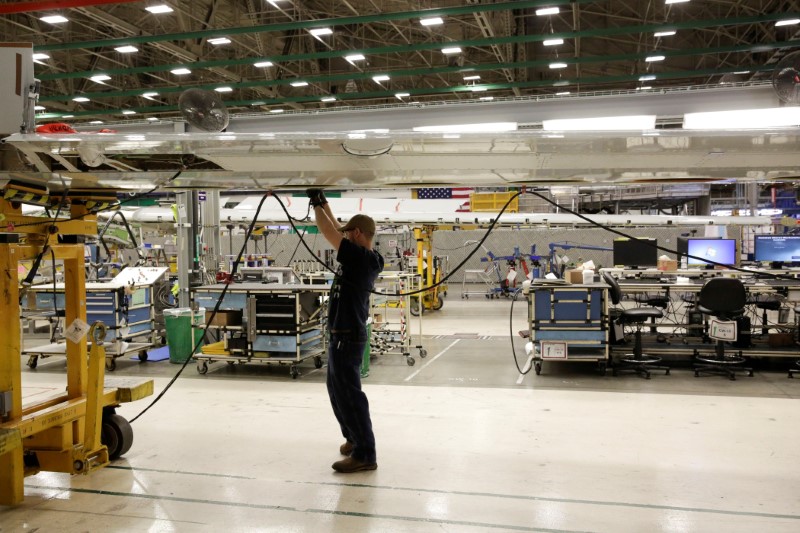 © Reuters. FILE PHOTO: A Boeing worker is pictured in the wing system installation area at their factory in Renton, Washington
© Reuters. FILE PHOTO: A Boeing worker is pictured in the wing system installation area at their factory in Renton, WashingtonBy Lucia Mutikani
WASHINGTON (Reuters) – U.S. producer prices barely rose in April after strong gains in the first quarter, held down by a moderation in the cost of both goods and services, which could ease fears that inflation pressures were rapidly building up.
The Labor Department said on Wednesday its producer price index for final demand edged up 0.1 percent last month after increasing 0.3 percent in March.
That lowered the year-on-year increase in the PPI to 2.6 percent from 3.0 percent in March.
Economists polled by Reuters had forecast the PPI gaining 0.2 percent last month and rising 2.8 percent from a year ago.
A key gauge of underlying producer price pressures that excludes food, energy and trade services also nudged up 0.1 percent last month. The so-called core PPI had increased by 0.4 percent in each of the past three months.
In the 12 months through April, the core PPI rose 2.5 percent after jumping 2.9 percent in March.
Last month’s slowdown in wholesale price growth is likely temporary as manufacturers have been reporting paying more for raw materials. Core goods prices increased 0.3 percent in April, matching March’s gain.
U.S. financial markets were little moved by the data.
Inflation is flirting with the Federal Reserve’s 2 percent target. The U.S. central bank’s preferred inflation measure, the personal consumption expenditures (PCE) price index excluding food and energy, increased 1.9 percent year-on-year in March and is expected to breach its target in the coming months.
This comes as last year’s big declines in prices of cell phone service plans drop out of the calculation.
Fed officials have in recent days signaled they would not be too concerned if inflation overshot the central bank’s target, reiterating a message in a statement issued at the end of a two-day policy meeting last Wednesday.
In that statement, policymakers said they expected annual inflation to run close to its “symmetric” 2 percent target over the medium term. The U.S. central bank left interest rates unchanged last week. The Fed hiked rates in March and has forecast at least two more increases for this year.
In April, the price of services ticked up 0.1 percent. That followed two straight monthly increases of 0.3 percent.
Services were restrained by a 3.2 percent drop in the cost of hotel accommodation, which was the biggest decline since September 2009.
The cost of healthcare services fell 0.2 percent after increasing 0.3 percent in March. Those costs feed into the core PCE price index.
Prices for goods were unchanged last month after rising 0.3 percent in March. Wholesale food prices declined 1.1 percent last month, the largest drop since August 2016, after surging 2.2 percent in March. Gasoline prices fell 0.4 percent in April after dropping 3.7 percent in the prior month.
Fusion Media or anyone involved with Fusion Media will not accept any liability for loss or damage as a result of reliance on the information including data, quotes, charts and buy/sell signals contained within this website. Please be fully informed regarding the risks and costs associated with trading the financial markets, it is one of the riskiest investment forms possible.
Source: Investing.com



























